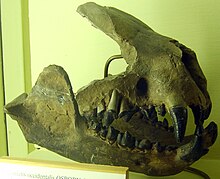Palaeonictis ("ancient weasel") is an extinct genus of placental mammals from extinct subfamily Palaeonictinae within extinct family Oxyaenidae, that lived in Europe and North America from the late Paleocene to the early Eocene.[9]
| Palaeonictis | |
|---|---|

| |
| skull of Palaeonictis occidentalis | |
| Scientific classification | |
| Domain: | Eukaryota |
| Kingdom: | Animalia |
| Phylum: | Chordata |
| Class: | Mammalia |
| Clade: | Pan-Carnivora |
| Order: | †Oxyaenodonta |
| Family: | †Oxyaenidae |
| Subfamily: | †Palaeonictinae |
| Genus: | †Palaeonictis de Blainville, 1842 |
| Type species | |
| †Palaeonictis gigantea de Blainville, 1842
| |
| Species | |
| Synonyms[5] | |
|
synonyms of genus:
| |
Description
editIn life, it would have resembled a large modern wolverine. This predatory mammal had heavy jaws and blunt robust teeth more suited for crushing bones, than slicing meat. This meant that the plantigrade Palaeonictis was at least a part-time scavenger. The biggest species, Palaeonictis peloria (meaning "terrible ancient weasel") is known from an incomplete jaw that must have measured over 20 centimetres (7.9 in) in length. This animal was the largest carnivore in its ecosystem. 55 million years ago, P. occidentalis (the size of a bear) evolved into the smaller P. wingi (the size of a coyote) within 200,000 years in the early Eocene due to global warming (paleoclimatology). By the end of the early Eocene (50 million years ago), Palaeonictis disappeared from North America, and by the early Eocene (55 million years ago) the last species of P. gigantea had vanished from Europe.[4] In fact, the entire family Oxyaenidae had become extinct worldwide (although its sister group Hyaenodonta continued to thrive for a while). This is traditionally assumed to be due to increased competition from miacids and nimravids belonging to the more successful order Carnivora, which eventually replaced earlier carnivorous mammal clades in the later Neogene as the world's top predators, though no evidence of direct competition is known, and carnivorans may have simply filled vacated niches.
References
edit- ^ de Blaineville (1842) "Ostéographie ou description iconographique comparée du squelette et du système dentaire des mammifères récents et fossiles pour servir de base à la zoologie et à la géologie." Livraison 10: Des Viverras. J.B. Baillière et Fils, Paris: 1–100
- ^ Osborn, H. F. (1892.) "Taxonomy and morphology of the primates, creodonts, and ungulates." In: "Fossil mammals of the Wahsatch and Wind River beds. Collection of 1891." (H. F. Osborn and J. L. Wortman), Bull. Amer. Mus. Nat. Hist., 4: 81-147
- ^ K. D. Rose. (1981.) "The Clarkforkian Land-Mammal Age and Mammalian Faunal Composition Across the Paleocene-Eocene Boundary." University of Michigan Papers on Paleontology 26:1-197
- ^ a b Stephen G. B. Chester; Jonathan I. Bloch; Ross Secord; Doug M. Boyer (2010). "A new small bodied species of Palaeonictis (Creodonta, Oxyaenidae) from the Paleocene-Eocene thermal maximum". Journal of Mammalian Evolution. 17 (4): 227–243. doi:10.1007/s10914-010-9141-y. S2CID 15058311.
- ^ J. Alroy (2002.) "Synonymies and reidentifications of North American fossil mammals."
- ^ E. D. Cope. (1880.) "On the genera of the Creodonta." Proceedings of the American Philosophical Society 19:76-82
- ^ T. Smith and R. Smith. (2001.) "The creodonts (Mammalia, Ferae) from the Paleocene-Eocene transition in Belgium (Tienen Formation, MP7)." Belgian Journal of Zoology 131(2):117-135
- ^ F. Solé, E. Gheerbrant, and M. Godinot. (2011.) "New data on the Oxyaenidae from the Early Eocene of Europe; biostratigraphic, paleobiogeographic and paleoecologic implications." Palaeontologia Electronica 14(2):13A:1-41
- ^ Stephen Jay Gould, John Barber & Peter Andrews (2001). The Book of Life. W. W. Norton & Company. ISBN 0-393-32156-8.